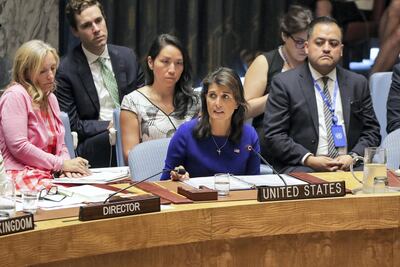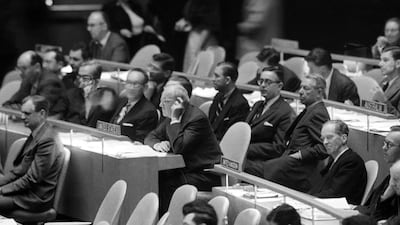In the 1930s, the United Kingdom’s Foreign and Commonwealth Office broached the subject of women joining the diplomatic service in a series of official committees.
The conclusion: it would be too risky to the country’s reputation abroad.
Sending women overseas on official business could not only be seen as a “bad joke,” according to one British official. Worse, foreigners would probably feel they were not being taken seriously if they were asked to receive her, said another.
“Others commented an attractive woman would not be taken seriously,” said Dr Nawal Al Hosany, the permanent representative of the UAE to the International Renewable Energy Agency, and deputy director general of the Emirates Diplomatic Academy. She was speaking in a session at Abu Dhabi's Diplocon event which charted the progress of women working in the field of diplomacy.
“It was a period when women were not permitted to join the diplomatic corps for fear of endangering a country’s prestige abroad," she said.
In 1946, women were finally permitted to sit the exam to join the diplomatic service in the UK. But it was not until the 1970s that restrictive rules in some countries which forced a woman to resign once she got married were rescinded.
“There is no doubt that since the 1930s women have come a long way in the field of diplomacy. But, as we all know, there is still much ground to be covered,” said Dr Al Hosany.
And a study released by Emirates Diplomatic Academy at Diplocon revealed the extent of that divide. Of 2,607 ambassadors from G20 countries, only 435 - or 16.7 per cent - are women.
Female diplomats were also less likely to secure the most prestigious postings, according to the survey.
Australia and Canada have the highest percentage of female diplomats, both with slightly over 35 per cent. Some countries have very few or none.
Change is needed, said members of a panel who discussed how to break the glass ceiling in diplomacy. But it was not going to happen naturally, they said. Achieving gender parity would require both a push and change in policies by governments around the world.

“Clearly, the systems work in favour of men,” said Susana Malcorra, former minister of foreign affairs of the Argentine Republic.
“That’s a fact. So unless you change the systems, you will not be able to get there and you have to change them in a very dramatic way so things do not take forever to get there.”
Ms Malcorra used to be against quotas but her view has since changed. “When I was young and thought that I knew everything, I said to myself that I will be good enough to prove things by my own doing,” she said.
“I learned later and now I am not so young and I recognise I am not so smart, that there are affirmative policies that are required to break this notion of a man’s club that exists in many environments,” she said.
Those policies would require a certain number of ambassadorial posts to be filled with women, she said.
“So my view is we need to introduce in the different ministries, metrics and figures that start to show incremental changes in different fields. Those metrics need to be broad and include different aspects of the work,” she said.
Australia is proof of how efforts to increase the numbers of women in the diplomatic service can lead to real results. Significant changes were made following a study found that the intakes of diplomatic graduates had been equal between men and women for 30 years. Yet at the end of that period, only a third of the senior positions and a quarter of ambassadorial posts were occupied by women.
Changes were introduced that included banning interruptions and a mandatory course on how to avoid unconscious biases.

“There has been a change but it’s not sufficient. We still don’t regard that number as high enough,” said Jean Dunn, director of the Indo-Pacific Centre for Political and Diplomatic Studies and a former Australian ambassador.
She was the first diplomat to give birth and return to work in her department, as well as being the first ambassador to have a child while serving abroad.
Fast-tracking women at certain points in their careers, when they are not taking time out to have children, could be key in increasing the number of female diplomats, said the panellists.
“There will be other moments that will be slow track, if I can use that phrase, because of their responsibility for bringing children to life is something that has to be recognised,” said Ms Malcorra.
But introducing policies which target men are important, too.
“Giving paternity leave alongside maternity leave is something that indicates that it is a shared responsibility,” said said Mohamed Abushahab, UAE Ambassador to the Kingdom of Belgium and the EU.
The goal of achieving parity is not about pitting women against men or men against women, they said.
“We are a society that is represented 50-50. And unless we get there in every field we will never really maximise the results of what we do as partners in society,” said Ms Malcorra.
“It is about when and how fast can we get there,” said Mr Abushahab.

The UAE has seven female ambassadors but a much higher number of female diplomatic staff - 38 per cent in the Ministry of Foreign Affairs are now women.
At least six in ten graduates from the academy, responsible for training the next generation of UAE ambassadors, were women last year.
The country has introduced a series of initiatives to support women’s advancement in the workplace, including the creation of the Gender Balance Council, as well as specific policies to increase the numbers of women working in the foreign service.
“Because of our cultural standing point, there were many women in the Ministry of Foreign Affairs who when they wanted to go on a diplomatic mission, because of our cultural environment, they were not able to travel on their own,” said Mr Abushahab.
So the government introduced a policy that if a woman wants to bring a family member with her, it will cover the cost of their trip too.
“What we have actually seen is that policy allowed women over time to be able to travel on their own. And what happened is that the family members who were accompanying them saw that they were advancing in their careers and saw that they didn’t need to worry about it so much, it became normalised,” said Mr Abushahab.
“So they started going on missions on their own and then we have examples of women who went on postings on their own with families and with husbands who moved over time because of this policy that encouraged their participation on missions.”
Dr Anwar Gargash, Minister of State for Foreign Affairs, who gave a keynote address, said he believed more and more “able and capable women” would go on to represent the country abroad in future.
“People will say Burj Khalifa or the Louvre [is the UAE’s greatest success]”, he said.
“We’ll also build the biggest malls, but what has happened in this country is more than skin deep. You can see it in people’s health, education and more cosmopolitan nature, people have actually changed. If I had to say one thing that I would consider as one of the UAE’s greatest achievements, it’s our record in enabling women.”
The UAE has enabled women very successfully in a conservative Arab society in a way that has broken stereotypes, he said.
“I think this has been a huge success for us, and it says a lot about who you are and where you want to be in this world,” said Dr Gargash.
“We are seeing this clearly in our diplomatic service. We have many successful ambassadors who are women and doing a great job. We have many young diplomats who are aspiring. I think this is extremely important.”
_________________
Diplocon report:
War games simulate India and Pakistan nuclear crisis at UAE summit
Minister fears voices of intolerance becoming louder across the globe
Nations must break up the diplomatic boys' club, UAE summit hears
Gargash: in the 15-minute news cycle, we can't afford to ignore criticism
Middle East states 'need to speak to their enemies'
_________________


